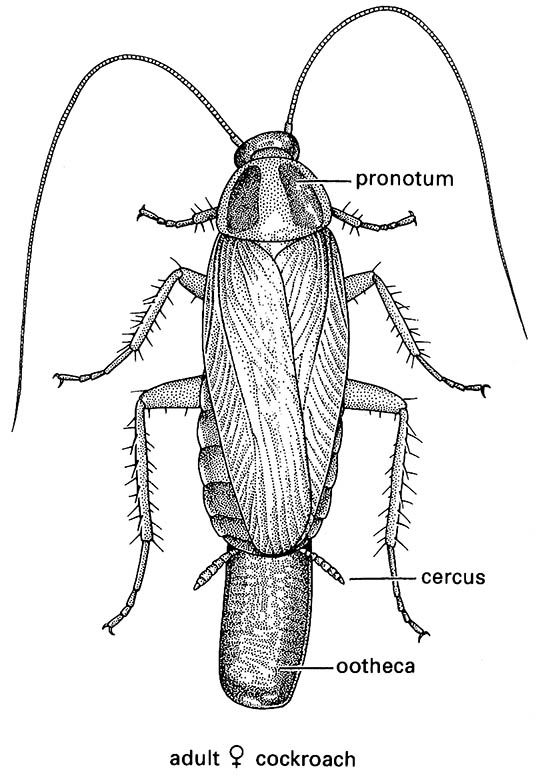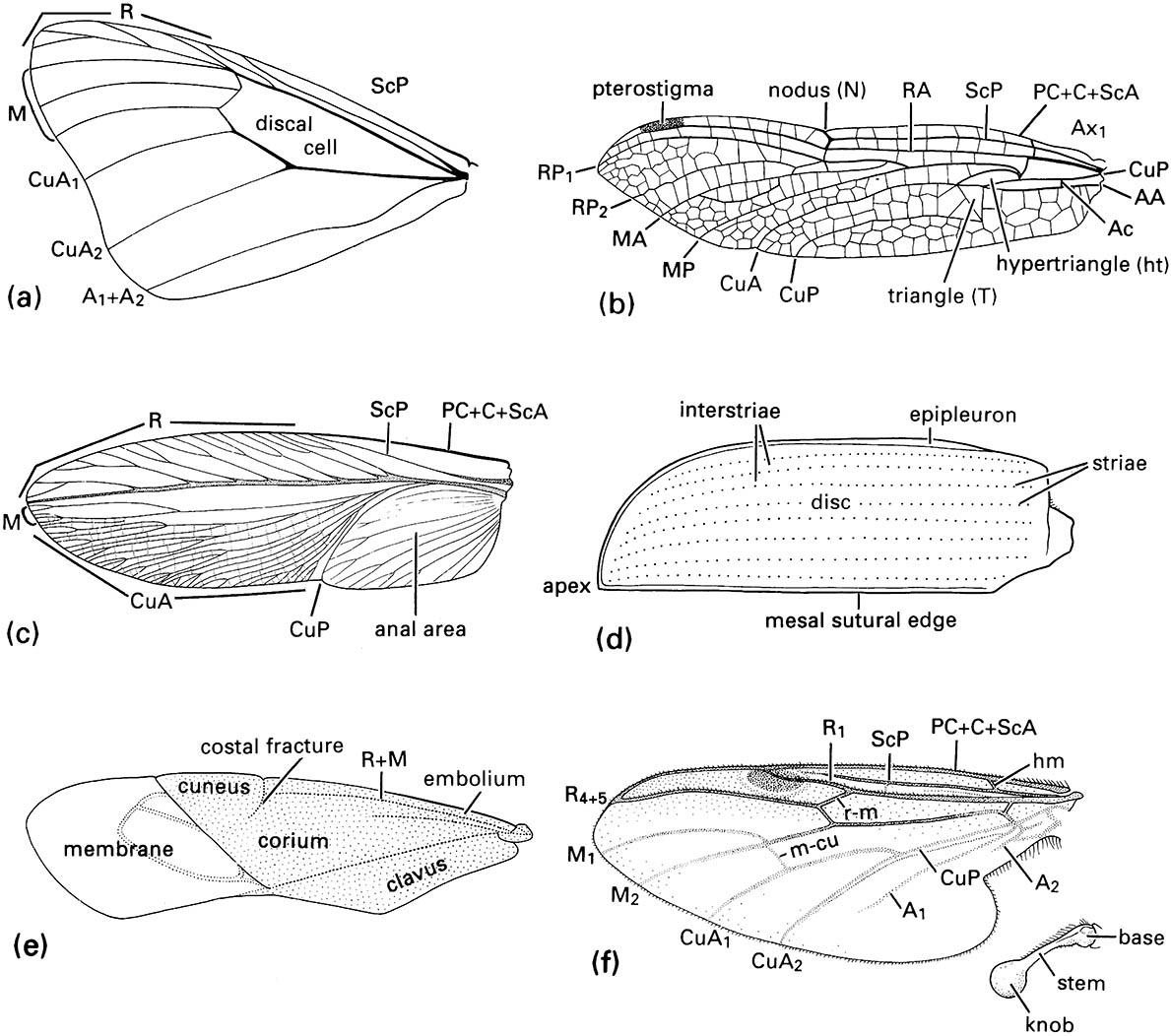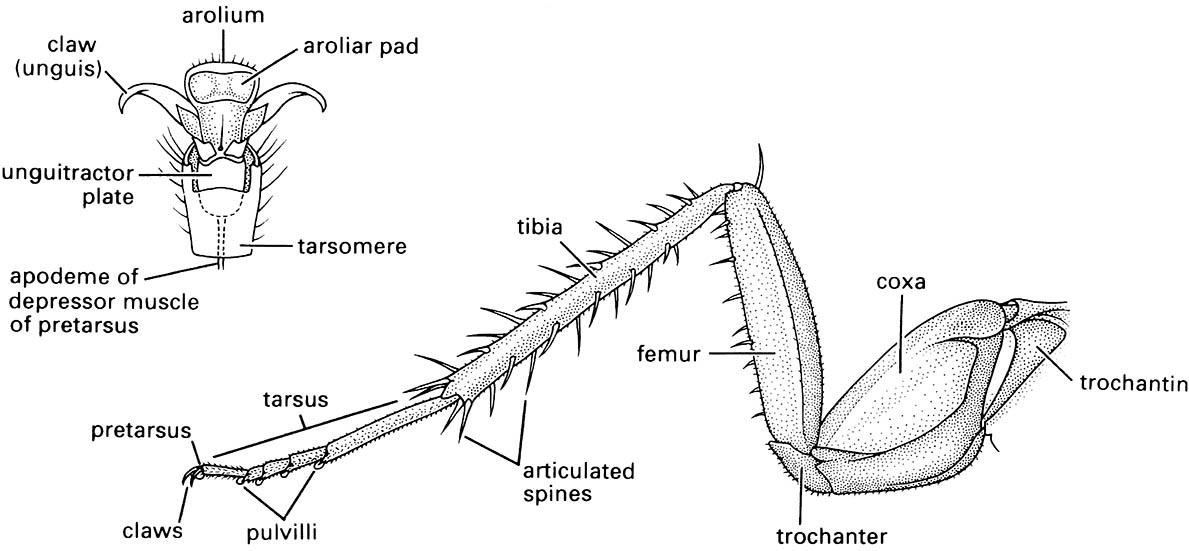Box 9.8. Blattodea (Blattaria; cockroaches, roaches)
The cockroaches make up an order of over 3500 species in at least eight families worldwide. They are hemimetabolous, with small to large (<3 mm to >100 mm), dorsoventrally flattened bodies. The head is hypognathous, and the compound eyes may be moderately large to small, or absent in cavernicolous species; ocelli are represented by two pale spots. The antennae are filiform and multisegmented, and the mouthparts are mandibulate. The prothorax has an enlarged, shield-like pronotum, often covering the head; the meso- and metathorax are rectangular and subequal. The fore wings (Fig. 2.22c) are sclerotized as tegmina, protecting the membranous hind wings; each tegmen lacks an anal lobe, and is dominated by branches of veins R and CuA. In contrast, the hind wings have a large anal lobe, with many branches in the R, CuA, and anal sectors; at rest they lie folded fan-like beneath the tegmina. Wing reduction is frequent. The legs are often spinose (Fig. 2.19) and have five-segmented tarsi.
The large coxae abut each other and dominate the ventral thorax. The abdomen has 10 visible segments, with the subgenital plate (sternum 9) often bearing one or a pair of styles in the male, and concealing segment 11 that is represented only by paired paraprocts. The cerci comprise from one to usually many segments. The male genitalia are asymmetrical, and the female’s ovipositor valves are concealed inside a genital atrium.
Mating may involve stridulatory courtship, both sexes may produce sex pheromones, and the female may mount the male prior to end-to-end copulation. Eggs generally are laid in a purse-shaped ootheca comprising two parallel rows of eggs with a leathery enclosure (section 5.8), which may be carried externally by the female (as illustrated here for a female of Blatella germanica, after Cornwell 1968). Certain species demonstrate a range of forms of ovoviviparity in which a variably reduced ootheca is retained within the reproductive tract in a “uterus” (or brood sac) during embryo- genesis, often until nymphal hatching; true viviparity is rare. Parthenogenesis occurs in a few species. Nymphs develop slowly, resembling small apterous adults.
Cockroaches are amongst the most familiar insects, owing to the widespread human-associated habits of some 30 species, including Periplaneta americana (the American cockroach), B. germanica (the German cockroach), and B. orientalis (the Oriental cockroach). These nocturnal, malodorous, disease-carrying, refuge-seeking, peridomestic roaches are unrepresentative of the wider diversity. Typically, cockroaches are tropical, either nocturnal or diurnal, and sometimes arboreal, with some cavernicolous species. Cockroaches include solitary and gregarious species; Cryptocercus (the woodroach) lives in family groups. Cockroaches mostly are saprophagous scavengers, but some eat wood and use enteric amoebae to break it down. Cryptocercus, uniquely in Blattodea, utilizes flagellate internal protists to digest cellulose.
Phylogenetic relations are discussed in section 7.4.2 and depicted in Figs. 7.2 and 7.4. Evidence presented in earlier editions of this textbook suggested that Cryptocercus convergently acquired its termite-like features, such as sociality and digestion of cellulose, via protists. Now this similarity appears to reflect actual relationships, with Isoptera having arisen from within Blattodea (Fig. 7.4). Although this renders the latter paraphyletic, we continue to use “Blattodea” until these relationships are confirmed.


(a) fore wing of a butterfly of Danaus (Lepidoptera: Nymphalidae); (b) fore wing of a dragonfly of Urothemis (Odonata: Anisoptera: Libellulidae); (c) fore wing or tegmen of a cockroach of Periplaneta (Blattodea: Blattidae); (d) fore wing or elytron of a beetle of Anomala (Coleoptera: Scarabaeidae); (e) fore wing or hemelytron of a mirid bug (Hemiptera: Heteroptera: Miridae) showing three wing areas — the membrane, corium, and clavus; (f ) fore wing and haltere of a fly of Bibio (Diptera: Bibionidae) (after J.W.H. Trueman, unpublished. ((a-d) After Youdeowei 1977; (f) after McAlpine 1981)

(After Cornwell 1968; enlargement after Snodgrass 1935)

Broken lines indicate uncertain relationships. Thysanura sensu lato refers to Thysanura in the broad sense. (Data from several sources)

The broken line indicates a paraphyletic taxon. (Data from several sources)



